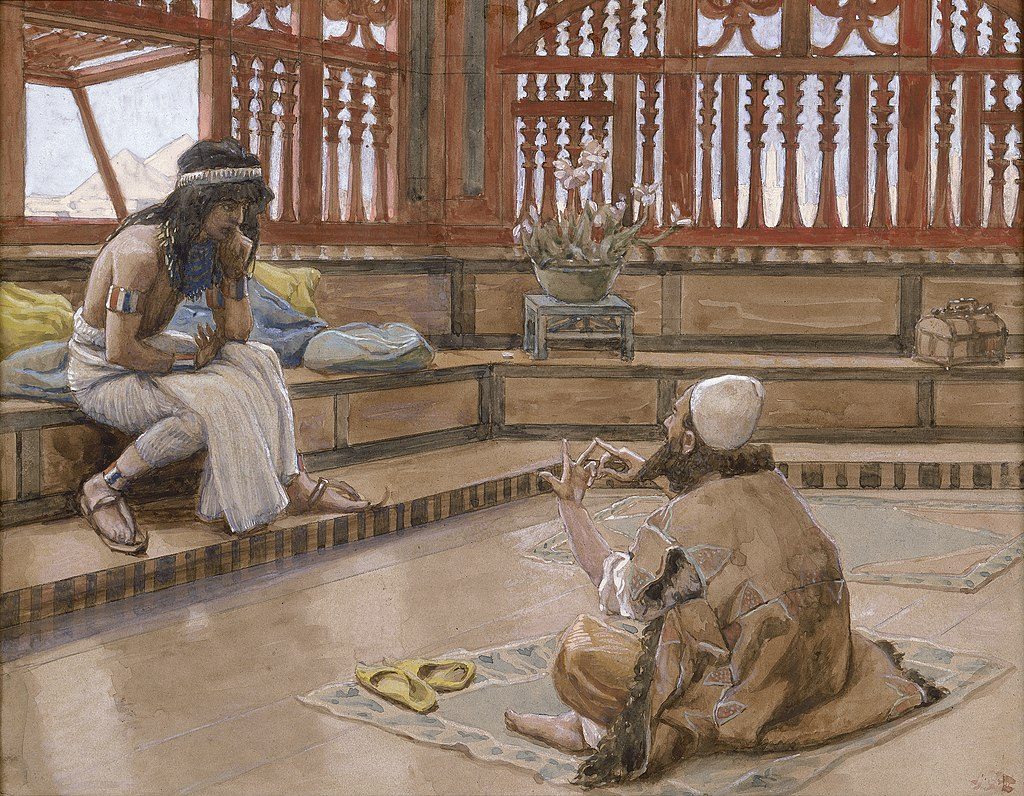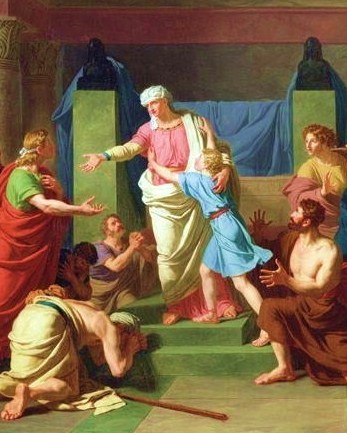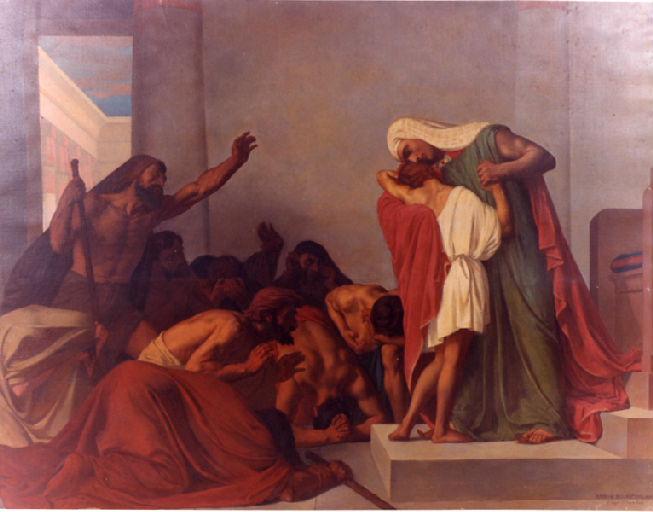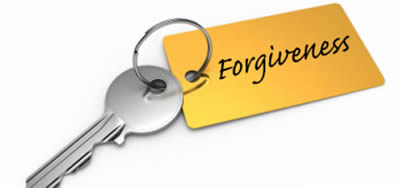And he approached
Our parashah begins with Yehudah approacing Yosef, recounting how they told Yosef that they had a father named Yaakov, who was an old man, and a little brother named Benyamin. Yosef had told the brothers to bring their younger brother Benyamin down to Egypt. They did. Now Yehudah is pleading on behalf of Benyamin, explaining to Yosef what would happen if he were to come to his father without Benyamin, seeing that his father’s soul was bound up with the child.

In our parashah Yosef, “making himself known to his brothers, then sent the brothers back to their father Yaakov, with a message to come and reside in the land of Goshen (a segregated part of Egypt to ensure that the ‘Hebrews would not assimilate into Egyptian culture’) (Bereishit 45:18). In spite all the wrong doing Yosef had to endure throughout his life, imposed by his brothers, Yosef wanted to help his family. Some may perceive Yosef’s life as a great. However his life was filled with so many untold suffering, anguish, and sadness. Yosef had to have a forgiven heart. Perhaps from Yosef’s story we could learn more about forgiveness, and hopefully be inspired to forgive. We will get back to it.

A brief intro to parashat Vayigash
We previously read that Yosef’s story began with a dream at the age of seventeen. Yosef had two dreams. In the first dream he and his brothers were in a field. They were binding grain into sheaves. Yosef’s sheaf arose and stood. The brothers’ sheaves surrounded Yosef’s sheaf and bowed to it. Yosef told his brothers of his dream. The Torah tells us that the brothers’ hatred for Yosef was heightened by this dream. Yosef’s second dream involved the sun, moon and eleven stars. Yosef envisioned these bodies bowing to him. Again, he related the dream to his brothers. He also retold the dream to his father.
Sibling rivalry
The Torah tells us that after hearing this second dream the brothers were jealous of him. Yosef was also the first son of Yaakov by Rachel. Maybe since Yaakov loved Rachel more than Leah and his concubines, it was a natural thing for him to love Yosef more than his other children. Another reason for his brothers resentment was when Yaakov gave a highly decorated coat to Yosef.
The straw that broke the camel’s back
The brothers had enough. They decided to protect themselves from the messages of the dreams, placing Yosef in a position that would prevent his ascension over the family. They sold Yosef to the merchants, and as a slave, Yosef would have little opportunity to gain power. Even if Yosef could overcome this obstacle, he would be far away from the brothers. He would not be able to bring his brothers under his rule. However, the brothers’ actions had the opposite affect. In Egypt, Yosef achieved power and authority. When a famine struck the region, Yosef prepared Egypt for the ordeal. The brothers were forced to travel to Egypt to seek sustenance. There, Yosef’s dream was fulfilled.
Yaakov and Yosef
As the story goes in our parasha, Yaakov accepted Yosef’s invitation, left for Goshen together with all his family and possessions. G-d communicated with Yaakov in a vision at night. He informed Yaakov not to fear going down to Egypt, despite its potential detrimental spiritual consequences, because it is there that G-d will in the future establish the Children of Israel as a great nation, despite the fact that they would dwell temporarily in a land steeped in immorality and corruption.
The seventy souls

The Torah then lists Yaakov’s offspring and hints at the birth of Yocheved, the future mother of Mosheh (Bereishit 46:8). The Torah states that in total, seventy souls descended into Egypt, where Yosef was reunited with his father after 22 years of separation. He embraced his father and wept, overflowing with joy.
Yosef’s mission
Yosef is now a fully assimilated Egyptian, married to an Egyptian wife, with two sons. He is enormously powerful, his position second only to that of the Pharaoh himself. Now, totally unexpectedly, he is confronted with his brothers, the memory of whom he had long swept into the dark recesses of his mind.

“I am your brother Yosef, whom you sold into Egypt! And now, do not be distressed and do not be angry with yourselves for selling me here, because it was to save lives that G-d sent me ahead of you. For two years now there has been famine in the land, and for the next five years there will be no plowing and reaping. But G-d sent me ahead of you to preserve for you a remnant on earth and to save your lives by a great deliverance. So then, it was not you who sent me here, but G-d.” (Gen. 45: 4-8). This is the first recorded moment in history in which one human being forgives another.
Forgiveness

According to the Midrash, G-d had forgiven before this, but not according to the plain sense of the text. Forgiveness is conspicuously lacking as an element in the stories of the Flood, the Tower of Babel, and The 5 cities of the plain (including Sodom and Gomorrah) . When Avraham prayed his audacious prayer for the people of Sodom, he did not ask G-d to forgive them. His argument was about justice not forgiveness. Perhaps there were innocent people there, fifty or even ten. It would be unjust for them to die. Their merit should therefore save the others, says Avraham. That is quite different from asking G-d to forgive. Yosef’s story is the first recorded moment in history in which one human being forgives another.
What is Forgiveness?
Forgiveness is the intentional and voluntary process by which a victim undergoes a change in feelings and attitude regarding an offense, let go of negative emotions such as vengefulness. The ability to wish the offender forgiveness doesn’t automatically mean a reconciliation. We don’t have to return to the same relationship or accept the same harmful behaviors from someone who has hurt us. The act of forgiveness is first and foremost for ourselves. It lets us move on from the past instead of leading bitterness and anger to upset our emotional well-being.

Yosef forgiveness
Yosef forgave. That was a first in history. Yet the Torah hints that the brothers did not fully appreciate the significance of his words. He said, ‘It was not you but G-d.’ He told them their act had resulted in a positive outcome. But all of this was theoretically compatible with holding them guilty and deserving of punishment. That is why the Torah recounts a second event, years later, after Yaakov had died. The brothers sought a meeting with Yosef fearing that he would now take revenge. The brothers used the word “forgive”- this is the first time it appears explicitly in the Torah – because they were still unsure about what Yosef meant. Does someone truly forgive those who sold him into slavery? Yosef wept that his brothers had not fully understood that he had forgiven them long before. He no longer felt ill-will towards them. He had no anger, no lingering resentment, no desire for revenge. He had conquered his emotions and re-framed his understanding of events.
Forgiveness versus anger
Forgiveness does not appear in every culture. It is not a human universal, nor is it a biological imperative. We know this from a fascinating study by American classicist David Konstan, “Before Forgiveness: the origins of a moral idea” (2010). In it he argues that there was no concept of forgiveness in the literature of the ancient Greeks. There was something else, often mistaken for forgiveness. There is conciliation of anger.
Yaakov and Esav
There is a classic example of conciliation in the Torah: Yaakov’s behavior toward Esav when they meet again after a long separation. Yaakov had fled home after Rivkah overheard Esav resolving to kill him after Isaac’s death (Gen. 27: 41). Prior to the meeting Yaakov sends him a huge gift of cattle, saying “I will appease him with the present that goes before me, and afterward I will see his face; perhaps he will accept me.” (Gen. 32: 21). When the brothers meet, Yaakov bows down to Esav seven times, a classic abasement ritual. The brothers meet, kiss, embrace and go their separate ways, but not because Esav has forgiven Yaakov.
Forgiveness in Judaism
Konstan argues that forgiveness first appearance is in the Hebrew Bible and he cites the case of Yosef. What he does not make clear is why Yosef forgives, and why the idea and institution are born specifically within Judaism. Judaism is primarily an ethic of guilt, as opposed to most other systems, which are ethics of shame. One of the fundamental differences between them is that shame attaches to the person. Guilt attaches to the act.
Shame versus guilt cultures
In shame cultures when a person does wrong he or she is, as it were, stained and marked. In guilt cultures what is wrong is not the doer but the deed, not the sinner but the sin. The person retains his or her fundamental worth (“the soul you gave me is pure,” as we say in our prayers). It is the act that has somehow to be put right. That is why in guilt cultures there are processes of repentance, atonement and forgiveness. Yosef is putting the brothers through a course in atonement, the first in literature. Yosef is thus teaching them, and the Torah is teaching us, what it is to earn forgiveness.
Forgiveness only exists in a culture in which repentance exists. The possibility of that kind of moral transformation simply did not exist in ancient Greece or any other pagan culture. Greece was a shame-and-honor culture that turned on the twin concepts of character and fate. Judaism was a repentance-and-forgiveness culture whose central concepts are will and choice. The idea of forgiveness was then adopted by Christianity, making the Judeo-Christian ethic the primary vehicle of forgiveness in history.
“Be the one who nurtures and builds. Be the one who has an understanding and a forgiving heart one who looks for the best in people. Leave people better than you found them.”-Marvin J. Ashton
Shavua Tov.

The 613 Mitzvot
In The Torah there are 613 commandments, mitzvot, also known as the Law of Moses (תרי״ג מצוות, taryag mitzvot). The 613 mitzvot are first recorded in the 3rd century CE, when Rabbi Simlai mentioned it in a sermon that is recorded in Talmud Makkot 23b.
The 613 commandments include 248 “positive commandments”, to perform an act (mitzvot aseh), and 365 “negative commandments”, to abstain from certain acts (mitzvot lo taaseh). The negative commandments number 365, which coincides with the number of days in the solar year, and the positive commandments number 248, a number ascribed to the number of bones and main organs in the human body.
Though the number 613 is mentioned in the Talmud, its real significance increased in later medieval rabbinic literature, including many works listing or arranged by the mitzvot. The most famous of these was an enumeration of the 613 commandments by Maimonides, The Rambam.
Many of the mitzvot cannot be observed now, following the destruction of the Second Temple, although they still retain religious significance. According to one standard reckoning, there are 77 positive and 194 negative commandments that can be observed today, of which there are 26 commands that apply only within the Land of Israel. Furthermore, there are some time-related commandments from which women are exempt (examples include shofar, sukkah, lulav, tzitzit and tefillin). Some depend on the special status of a person in Judaism (such as kohanim), while others apply only to men or only to women.
According to Rambam Organized by Parsha. based on Wikipedia and http://www.vaadrv.org/rambam613mitzvot.asp ONE BIG IMPORTANT NOTE WHEN USING THIS LISTING: This listing is not all inclusive. Rambam may site multiple sources for a mitzvah is his works but this list currently only gives one source for each mitzvah.
One Mitzvah in Parashat Vayishlach
- Mitzvah#194- Not to eat the sinew of the thigh Gen. 32:33

#####
Check out YedidYah “Let There Be Light” a song about The Story of Creation. Music and Lyrics by Rabbi Yakira Yedidia https://www.youtube.com/watch?v=H0GEYQYwDI0
This blog article was inspired by chabbad.org

